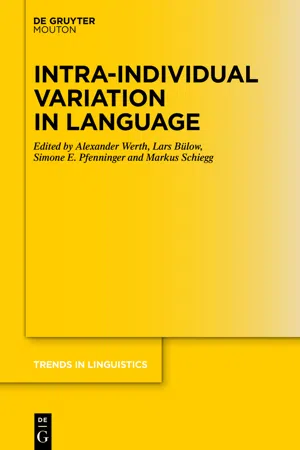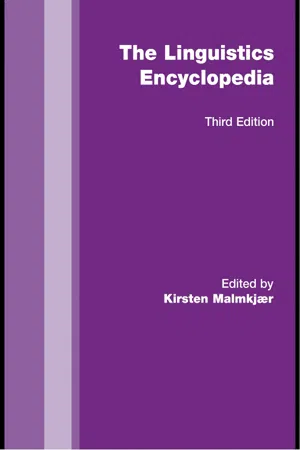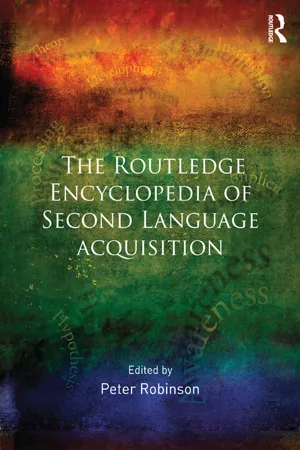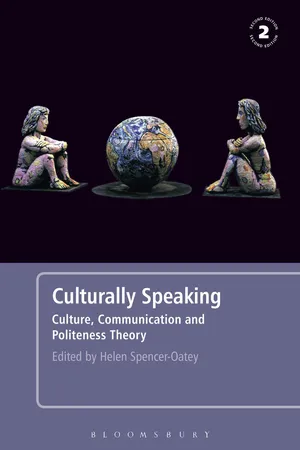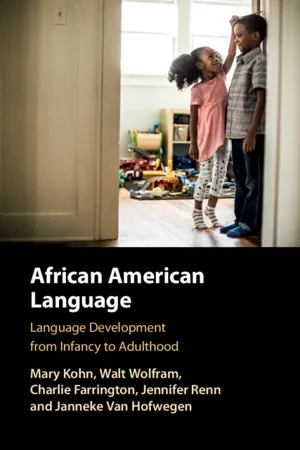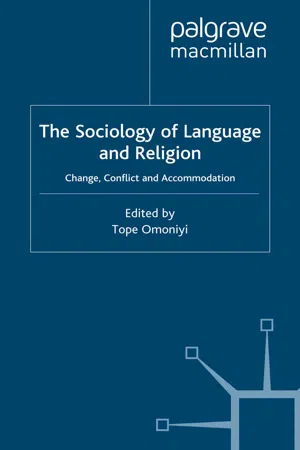Languages & Linguistics
Phonetic Accommodation
Phonetic accommodation refers to the tendency of individuals to adjust their speech patterns to match those of their conversation partners. This can involve changes in pronunciation, intonation, and speech rate. Phonetic accommodation is a natural and often subconscious process that occurs during communication, and it can help to facilitate social interaction and understanding between speakers.
Written by Perlego with AI-assistance
Related key terms
1 of 5
8 Key excerpts on "Phonetic Accommodation"
- eBook - ePub
- Alexander Werth, Lars Bülow, Simone E. Pfenninger, Markus Schiegg, Alexander Werth, Lars Bülow, Simone E. Pfenninger, Markus Schiegg(Authors)
- 2021(Publication Date)
- De Gruyter Mouton(Publisher)
This paper presents the results of an analysis of production data obtained from twelve female native Spanish learners of L2 German recorded during a collaborative map-task in order to investigate Phonetic Accommodation. Phonetic Accommodation is a process by which speakers increasingly select variants produced by an interlocutor in conversation. The focus of the study is on the realisation of neutralisation of final voicing contrast in plosives, a process found in German but not in Spanish according to existing contrastive analysis. Two main objectives were pursued in the study: (i) whether Phonetic Accommodation varies depending on the proficiency level of the participants as well as that of the interlocutor and (ii) whether individual subsegmental characteristics are affected differently. The findings show that both proficiency level and interlocutor influence the degree of accommodation. The findings also reveal that not all analysed subsegmental cues show comparable accommodation effects, and that the realisation of individual subphonemic cues leads to a high degree of inter- and intra-speaker variation. The greatest accommodation effects were found in conversations of highly proficient, non-native participants with a native speaker of German but also with a highly proficient non-native interlocutor. Participants with lower proficiency levels showed comparatively fewer accommodation effects. The degree of intra-individual variation seems to vary depending on proficiency level, in that the distribution of target-like and non-target-like realisations differs between L2 speakers of high and low proficiency. However, both target-like and non-target-like realisations occur in the speech samples of all L2 speakers.Keywords: Phonetic Accommodation, neutralisation of final voicing contrast, proficiency level, collaborative map-task,1 Introduction
Intra-individual variation (IAV) in the realisation of phonetic details or subphonemic cues as well as in the representation of phonological categories has frequently been documented in interactions of multilingual individuals (cf. Flege 1995 ; Fabiano-Smith et al. 2010 ; Jiang 2010 ). Such variation can occur because of automatic and spontaneous or intentional and conscious imitation of perceived characteristics in an interlocutor’s or a model speaker’s speech. That means the individual produces different variants in the course of a single conversation resulting from perceptually guided changes in speech production. The variation occurs at any level of speech production and is referred to as speech accommodation (or simply accommodation) (e.g. Tobin et al. 2017 ). Phonetic Accommodation is a subset of speech accommodation that considers accommodation effects at the phonetic level only. A specific case of Phonetic Accommodation is phonetic drift (Sancier and Fowler 1997 ), referring to cross-language effects resulting from exposure to a language that an individual is familiar with but not constantly using.1Within the field of language acquisition, a phenomenon might be considered a macro-level of accommodation when interlocutors consciously or unconsciously switch the entire language because of insufficient proficiency or volitional discourse strategies in multilingual communications. In addition to psycholinguistic aspects and aspects of communication design, grammatical constraints permitting or prohibiting language switches within and across sentences have also been previously investigated (cf. Myers-Scotton 2002 ; Clyne 2003 ; Riehl 2014 ; Müller 2017 ). The type of accommodation that is the focus of the present chapter may be considered the micro-level of accommodation. It is concerned with individual linguistic aspects, which have been attested on all linguistic levels (e.g. for syntax see Bock 1986 ; Gries 2005 ; for morphology see Trudgill 1986 ; Dunstan 2010 ; for semantics (and pragmatics) see Heim 1992 ; Beaver and Zeevat 2007 ; Liberman 2012 ; for lexical choice see Van Baaren et al. 2003 ; Jacob et al. 2011 ; for phonetics and phonology see Sancier and Fowler 1997 ; Pardo 2006 ; Nilsenová et al. 2009 ; Fabiano-Smith et al. 2010 ; Chang 2013 ; Pardo et al. 2013 ; Tobin et al. 2017 - eBook - PDF
- Grzegorz Dogil, Susanne Maria Reiterer, Grzegorz Dogil, Susanne Maria Reiterer(Authors)
- 2009(Publication Date)
- De Gruyter Mouton(Publisher)
Such intended maintenance may, however, often be interpreted as diverging from the in-terlocutor (Shepard et al. 2001). Different social roles and the situational context have also been proven to influence partners’ behavior in interaction. Men were, e.g., observed speaking with a lower voice while talking to women (Hogg 1985) and the power structure within a dyad influences the choice of up- or downward accommodation (towards a higher or lower socially rated speech variety; Street 1982; Giles et al. 1991). 1.2. Research on phonetic convergence Despite the relatively large number of studies devoted since the 1970’s to accommodation in lexical, syntactic and phonetic aspects of speech, it has been only recently that phonetic convergence has been defined in terms of an increase of segmental and suprasegmental similarities be-tween the interacting speakers (Pardo 2006). Phonetic convergence so far has been studied by extracting features such as speaking rate (e.g., Street 1984), fundamental frequency and am-plitude contours (e.g., Gregory 1990), voice onset time (Sancier & Fowler 1997), amplitude, utterance duration and rate within a human-computer interface (Oviatt, Darves & Coulston 2004) or by conducting perceptual similarity experiments (Pardo 2006). Most of the studies though investi-gated phonetic convergence in a strictly native language environment. Sancier and Fowler (1997), as one exception, concentrated on the gestu-ral drift between the two languages of an American English-Brazilian Portuguese bilingual speaker. The essential role of accommodation in a second language acquisition context has been recognized by Zuengler (1991) in her analysis of data on native-nonnative or fully nonnative con-versational interactions. Research on Phonetic Accommodation involuntarily raises the question of the nature and role of the perception-production link. - eBook - ePub
- Kirsten Malmkjaer(Author)
- 2009(Publication Date)
- Routledge(Publisher)
Language-attitudes research indicates, above all, that listeners can – and will – rapidly stereotype speakers’ personal and social attributes on the basis of language and dialect cues, and in ways that seem to affect important social decisions made about them. Expanding upon this solid foundation, there has recently been something of a move away from traditional research paradigms, and towards an increased concern for both theory development and more expansive investigative models. Promising new approaches involve the relationships between speakers’ language varieties and listeners’ own social identities (Cargile and Giles 1997), and the evaluative implications of interactions among speaker dialect, speech style and narrative content (Garrett et al. 2003). As well, a new ecological approach (Giles et al. 2006) builds upon recent insights into communication patterns and attitudes at the level of local community infrastructure, combining them with social-process models of attitude (see Bradac et al. 2001). The advantage here is that the latter typically emphasise more individual and fine-grained approaches, while the former has been more concerned with the socio-cultural factors that contextualise interactions. Among other things, this new and more inclusive thrust will be better able to both encourage and reflect studies of the detailed linguistic specifications of stimulus speech samples – studies for which researchers are increasingly calling (e.g., Edwards 1999).A related area with an important and burgeoning literature has to do with the accommodations made by speakers in different contexts and with different interlocutors (Gallois et al. 2005). Linguistic accommodation can take many forms but, whether it operates at or below the level of conscious awareness, its fundamental feature is the modification of speech patterns to converge with, or diverge from, those of others. Accommodation can reflect individual concerns – wanting to sound more like the boss, or intentionally departing from the usage of someone you dislike – or group ones: you may wish to emphasise your ‘in-group’ membership, or to solidify an ethnic or class boundary. Attitudes clearly underpin accommodative practices (Giles and Ogay 2006). Recent work by Pickering (e.g., 2006) is contributing to an expansion of scope here, as the ‘psychology of dialogue’ provides a natural bridge between traditional accommodation insights and work in conversational and discourse analysisConclusion
The comprehensive study of language attitudes is an interdisciplinary and multidimensional enterprise that has provided us with much useful information about the communicative process. It continues to expand in new directions and to embrace new insights. The central questions, however, have proved remarkably stable. What are the essential contributions that attitude makes to social interaction? What are the bases upon which evaluations and judgements are made? Why do the same broad evaluative dimensions reveal themselves as important across contexts? How are linguistic differences often translated into assessments of ‘better’ or ‘worse’, and how can scholarly insight lessen the impact of unenlightened opinion in this regard? How is it that linguistically stigmatised individuals and groups come to accept such opinion? Why does such acceptance not lead to the eradication of language varieties of low status and prestige? What, then, are the attitudinal aspects that figure in language maintenance and language shift? - Peter Robinson(Author)
- 2012(Publication Date)
- Routledge(Publisher)
A DOI: 10.4324/9780203135945-1 Accommodation KimMarie Cole SUNY Fredonia In the field of socio-linguistics, accommodation is valued for its explanations and predictions of individual variation. As described below, second language acquisition (SLA) researchers have used accommodation to account for differences in learners’ language use with native speakers and how it accounts for some linguistic features of input. While empirical studies are relatively few in number, Tarone’s (2007) review includes accommodation among sociolinguistic theories of SLA. Beebe and Giles (1984) first present an overview of Speech Accommodation Theory (SAT) and its applications to second language acquisition. Its key propositions include convergence and divergence, active strategies used by learners based on their assessment of the perceived relationship between their language and that of their interlocutors. When speakers like or identify with their speakers or have an instrumental purpose for speaking, their speech converges. They are likely to model their speech on that of their interlocutor, using similar linguistic features. Conversely, when speakers feel a lack of identification or a perceived threat to their language, they accentuate linguistic differences, or diverge from their interlocutors. In terms of SLA, the model suggests that those learners who perceive the new language as a threat to their first language would not seek opportunities to practice the second and would therefore not develop second language proficiency. Conversely, learners, who see the second language as complementary to their first would achieve higher proficiency- eBook - PDF
Culturally Speaking Second Edition
Culture, Communication and Politeness Theory
- Helen Spencer-Oatey(Author)
- 2008(Publication Date)
- Continuum(Publisher)
Rather, it could be mediated by 'interpersonal accommodation processes'. Giles pointed out that the interviewees in Labov's studies may well have been responding, consciously or subconsciously, to the interviewer's own speech style; that is, they may have been 'accommodating' linguistically. For exam- ple, they could have produced casual-sounding speech because the interviewer himself had shifted style and was using a less standard accent. Alternatively, they could have been differentiating themselves from a standard-sounding interviewer. In fact, Labov's results were reliable enough to make it unlikely that any general explanation could be given along these lines. But Giles had argued convincingly that the interpersonal dimension of language use was potentially of crucial importance. In general, speech 8.2 Central concepts of accommodation theory 166 Culturally Speaking modification could be viewed not so much as determined by the social context, and more as a speaker's dynamic and subjective response to the addressee. The degree of behavioural matching between speakers needed to be analysed, and linked to social psychological factors which could explain and predict it. The positive matching process was called convergence - 'a strategy whereby indivi- duals adapt to each other's communicative behaviours in terms of a wide range of linguistic/prosodic/non-verbal features' (Giles et al. 1991: 7). As the definition suggests, convergence can operate well beyond accent variables. Speech rate and patterns of pausing, utterance length, gestures, posture, smiling, gaze and so on can all feature in acts of convergence between speakers. The basic metaphor here is one of parallel and non-parallel lines, as if speakers' trajectories can be modelled as getting closer or further apart as talk proceeds. Indeed, convergence can be almost literally demonstrated in these terms, if we are able to quantify relevant aspects of speakers' communicative behaviour relative to one another. - eBook - PDF
African American Language
Language development from Infancy to Adulthood
- Mary Kohn, Walt Wolfram, Charlie Farrington, Jennifer Renn, Janneke Van Hofwegen(Authors)
- 2020(Publication Date)
- Cambridge University Press(Publisher)
Upon close consider- ation, we can see that this framework is quite complex to implement in analytical practice. What does accommodation actually look like in real inter- actions? What are the measurable units involved? How can we gauge whether a particular group in interaction has in fact accommodated to a sufficient or 137 6.2 Communication Accommodation Theory and Linguistic Variation significant degree? Finally, how might we be able to measure accommodation across many interactions? A review of the variationist literature shows many instances in which analysts have addressed the first three questions in meaningful ways (e.g., Coupland 1980, 1984; Rickford and McNair-Knox 1994; Hazen 2000; Schilling-Estes 2004). To be sure, there is much to be learned from an in- depth analysis of one or a small number of linguistic variables in the speech of just one person as they interact with more than one interlocutor. However, in this new era of “big data,” with publicly available large-scale corpora compris- ing millions of words – with data from many, many speakers of all stripes – we now have the ability to answer larger, population-level questions about accom- modation. Macroscale analysis can shed brighter light on the dynamics of linguistic change and sociological phenomena that a microscale study might only dimly illuminate. 6.2.1 Accommodation in Adolescent Speech What is known about peer influence on adolescent speech, particularly African American adolescent speech? As discussed in Chapter 5, we know that a child’ s earliest models for language acquisition come from their caregivers; we also know that beyond the age of four, it is virtually impossible to control for caregiver effects (Foulkes et al. 2005) on a child’ s speech. In reality, once a child enters school all bets are off as to which are her most profound linguistic influences. Especially during adolescence, peer influence becomes perhaps the most prominent input source. - eBook - PDF
- Various Authors(Author)
- 2021(Publication Date)
- Routledge(Publisher)
These "facts" are, of course, the active linguistic markers described earlier, and they take the form of different values or (following speech accommodation theory, see Street & Giles, 1982) changes in value for linguistic variables at all levels of lan- guage from phonetics to discourse. Thus, speech is involved in encounter 10. Interpersonal Accommodation and Situational Construals 267 definition by creating some of the data on which definitional models are built, and also as a medium through which they are negotiated and ex- pressed. Once some degree of situation definition is achieved, the participants' shared definitional model enables them to generate linguistic variants which can function as passive markers of the defined situation. SOCIAL PSYCHOLOGY AND LANGUAGE Social psychology's key theoretical contribution to sociolinguistics has been to elucidate the psychological complexities underlying the distribu- tions of linguistic markers according to setting, participants, goals and other social factors which Hymes {1967) and others have placed on the taxonomic agenda. In so doing, it has begun mapping the most social of social phenomena, language, into the most theoretically fertile concepts of social psychology, such as attitudes, lay explanations and social identity. In this section of the chapter, we note some aspects of this mapping and we suggest further possibilities. Intergroup Relations Recent social-psychological writing on intergroup relations has ·high- lighted the importance of specifically intergroup processes, emergent from the intergroup context itself, as they affect the experience and actions of individual group members (e.g., Austin & Worchel, 1979; Turner & Giles, 1981). This contrasts starkly with a previously popular presumption that the study of individual and interindividual processes alone would even- tually lead to the explanation of intergroup phenomena. - eBook - PDF
The Sociology of Language and Religion
Change, Conflict and Accommodation
- Tope Omoniyi(Author)
- 2010(Publication Date)
- Palgrave Macmillan(Publisher)
1 Introduction: Change, Accommodation and Conflict Tope Omoniyi The concepts of change, accommodation and conflict that are our focus in this volume are not new to the older traditional disciplines of sociology, social psychology and religion where they are experiential social phenomena that both characterize and define the relationships between two states of being, contexts or persons/groups. While change frames discussions of the transition between and into states, contexts and selves, conflict and accommodation are probable responses to such changes, one resisting and diverging the other embracing and con- verging. As a hybrid discipline, sociolinguistics had inherited these concepts but confined the experiential to language behaviour as we find when accounting for variation in different fields of linguistic analysis – phonology, lexis, morphology, syntax, pragmatics and dis- course. Giles and Powesland refer to the ‘individual speaker’s diversity of speech possibilities’ which warrant choice-making and modification aimed at ‘controlling the way in which he is perceived by the listener’ (1975: vi). They say that we accommodate in speech through speed of delivery, pitch range, phonological variables and vocabulary. These are all micro-level linguistic measures. The underlying thought then is the pursuit and preservation of harmony in society by managing the potential impact of social demarcations and difference based on speech performance. In the sociolinguistic literature, conflict has been theorized tradition- ally along social class lines, anchored as it were to Marxist thinking and especially the works of Marx, Lenin and Weber. Class and capitalism, technology, and division of labour-derived hierarchies have been cen- tral to articulations of conflict in the social sciences (Giddens and Held 1982). These demarcations and differences mostly served to identify 1
Index pages curate the most relevant extracts from our library of academic textbooks. They’ve been created using an in-house natural language model (NLM), each adding context and meaning to key research topics.
